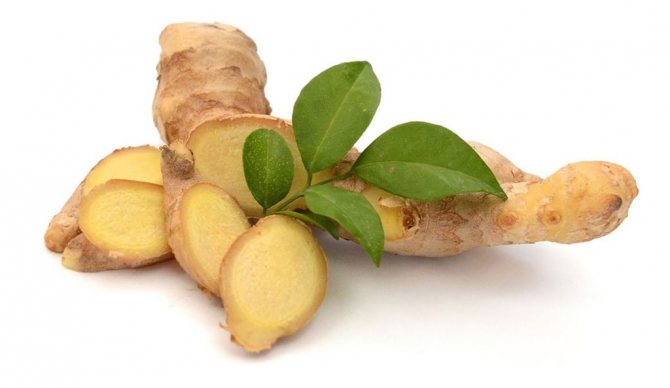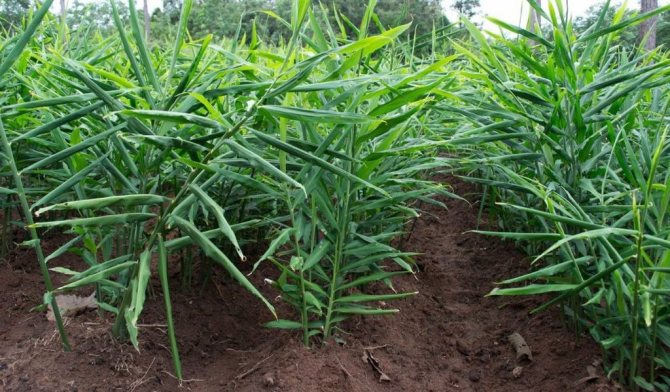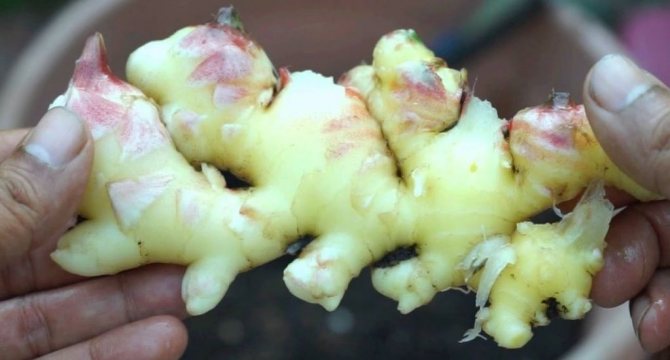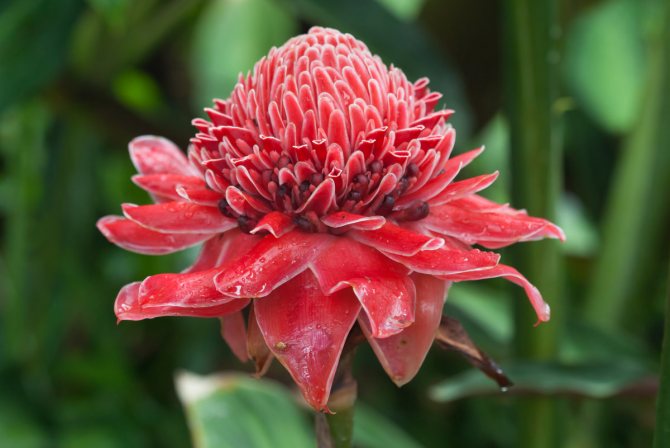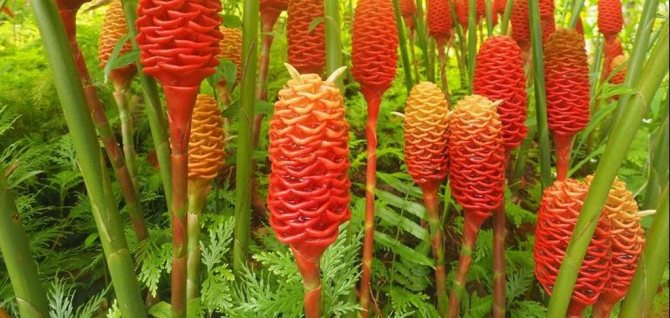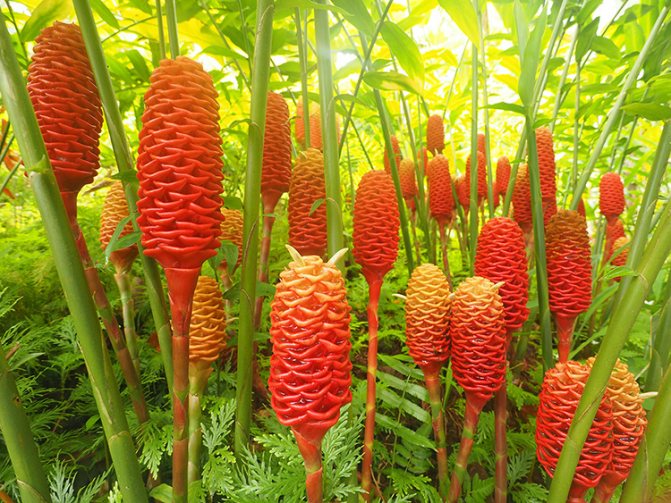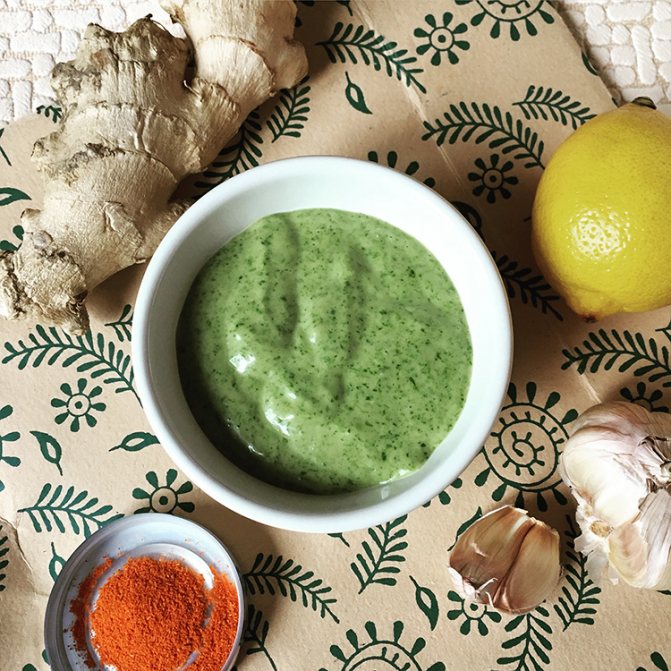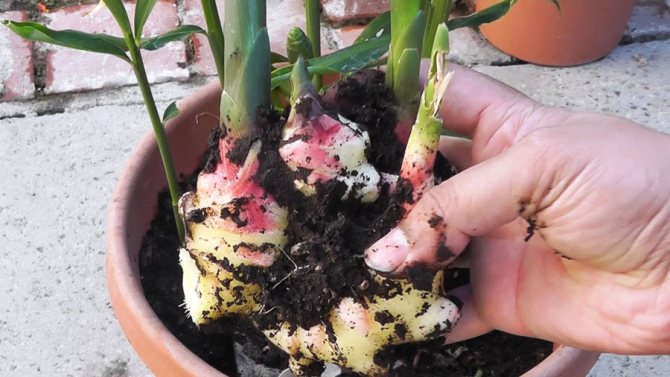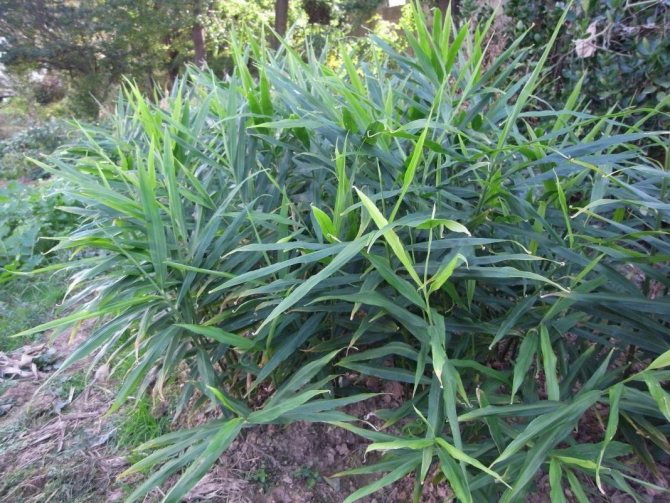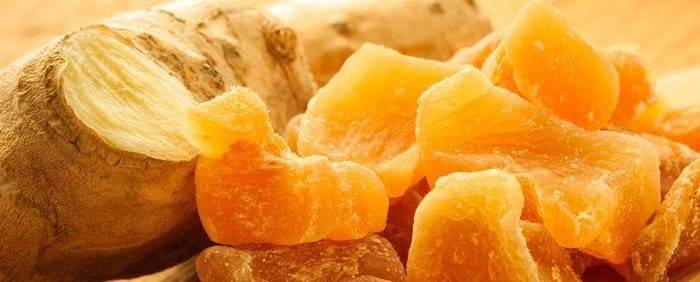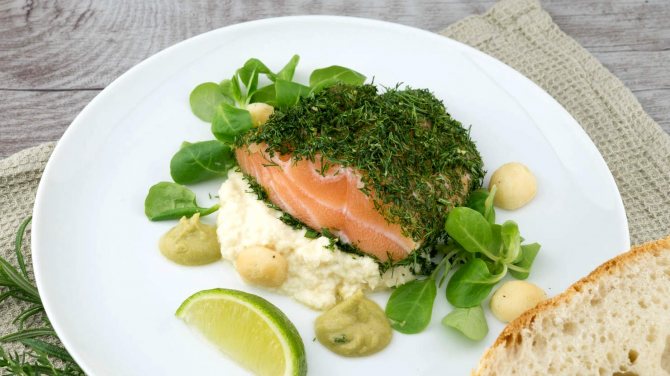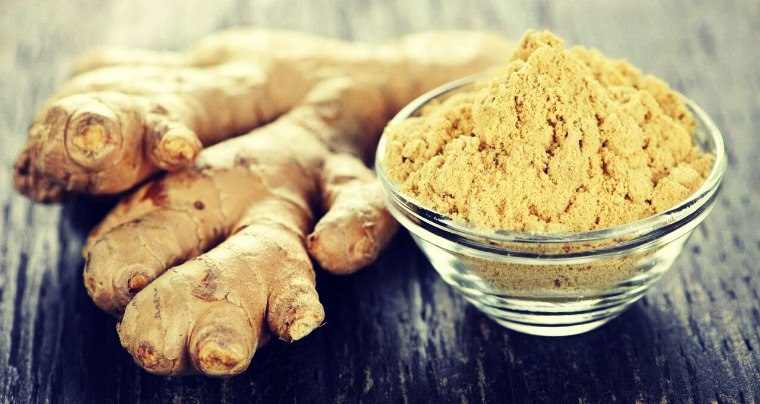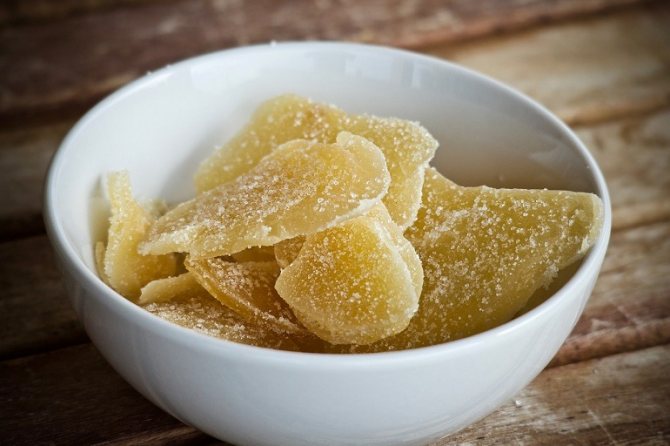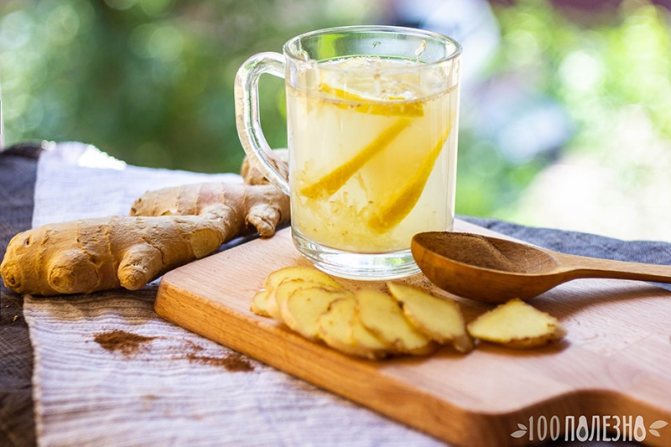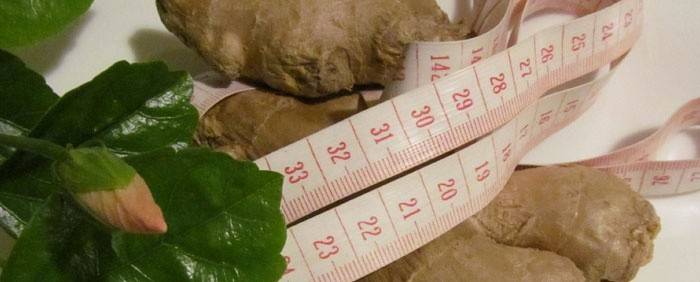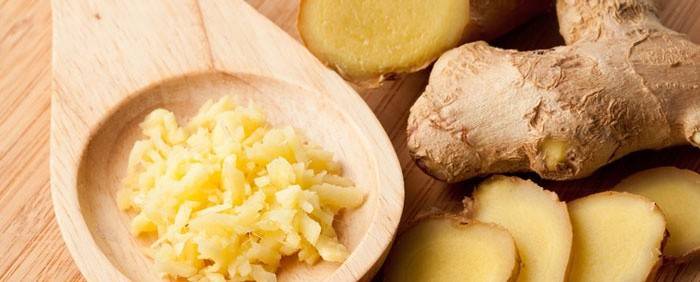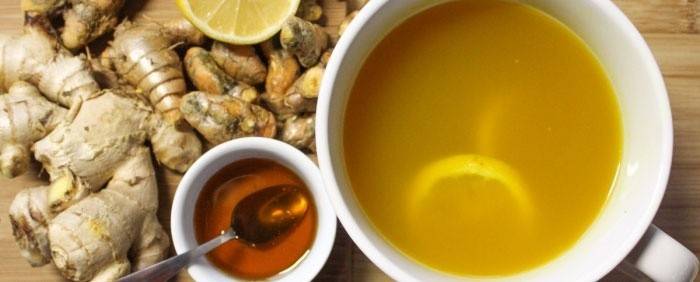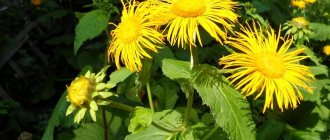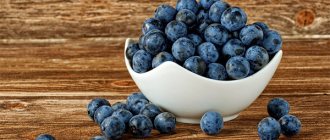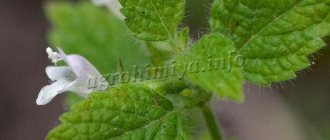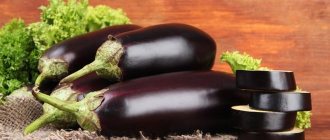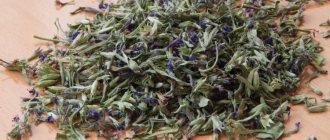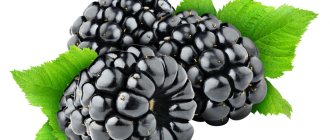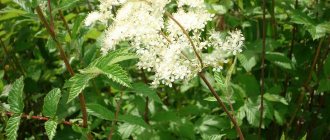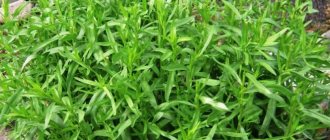In the past few years, an outlandish product has appeared on supermarket shelves and in markets that some have only heard of, while others have been actively using for many years - this is ginger root.
Its health benefits are undeniable. It is known for its healing properties for colds, flu and other ailments. It is used in cooking as a seasoning, in cosmetology, as an active component of various creams and masks. However, experts say that it can bring not only benefits, but also harm. But first things first. First, let's figure out what it is.
Product description
If you have seen ginger only as a root of a beige or yellowish-gray hue, then you will be interested to know what this plant looks like in its entirety. The plant is perennial. Its homeland is a country predominantly in tropical and subtropical climates (Australia, India, Barbados, South Asia). The largest exporter is China.
You can grow ginger in your own garden or on the windowsill, although this will require creating favorable conditions. It is a cane-like trunk, about one and a half meters in height with spike-shaped inflorescences. Flowers can be of various shades of yellow, as well as from beige to brown. The plant propagates by rhizomes. The roots themselves are in the form of medium-sized tubers (somewhat reminiscent of Jerusalem artichoke roots, but flatter). They are used after peeling them off. In the middle, the root is fleshy and sinewy, it contains a lot of juice. The taste is a combination of hot, spicy and sweet.
They use both fresh roots and dried ones, crushed into powder. You can see them in sugar or pickled (often served as a sushi seasoning). Of course, the best and most useful is fresh roots. As a seasoning, they are added to various meat, vegetable and fish dishes; tea is brewed with them. In Europe, the plant became known in the middle 14th century, when seafarers brought it there. He gained particular popularity at a time when plague was raging in Europe. People believed that its medicinal properties protect against plague infection. The plant began to be widely used in the 16th century, after it was brought to America.
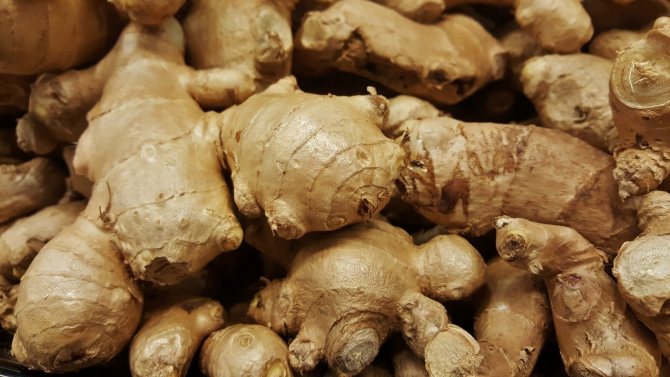
Description of the plant
Ginger flower can be decorative and medicinal, which is also used in cooking. The plant is native to places where the tropical climate prevails. Therefore, for comfort, it is necessary to provide high humidity and warmth.
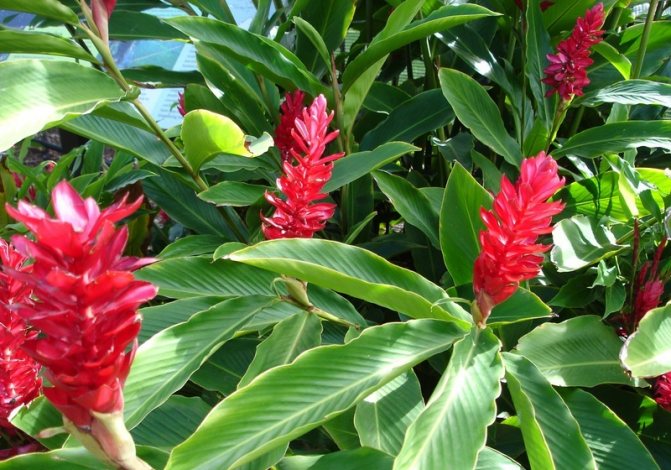

Ginger during flowering
Appearance
When discussing ginger, what it is, first of all, they remember its root, similar to Jerusalem artichoke. It is a tuberous plant that is often called an earthen pear. Many do not even think about what the ginger plant looks like.
Ornamental species are distinguished by more colorful flowering. Ginger, used in medicine and cooking, does not bloom so abundantly as to direct forces towards the formation of a powerful rhizome. The plant, due to its external resemblance, is compared to a reed. But his stem is not covered with scales.
Bloom
Ginger blooms in spring and summer, and at home it is extremely rare. With proper care and comfortable conditions, flowers appear in the third year of life. The color depends on the type of exotic representative of the flora. The most common shades:
- brown;
- orange-yellow;
- red.
What does a ginger plant look like:
- The inflorescences resemble ears formed at the top of the stem from leaves rolled into a tube. They can be monochromatic or combine several shades;
- The shape of the inflorescences is varied. They look like cones, lilies, peonies.
Note! The flowering period is accompanied by the spread of a sweet aroma. It can lead to allergic reactions. With the onset of cold weather, flowering ends.
Leaves
Leaves begin to grow at the root. They are narrow and reach a length of 20 centimeters, while the plant itself can grow up to two meters. At the ends, the leaves are pointed, have scales.
Root
The root of the plant is practically on the surface, in the upper layer of the soil. An underground stem covered with leaves is often confused with it. Inside, it is yellow and fleshy. The rhizome develops and releases ground stems. Leaves and inflorescences are subsequently formed on them.
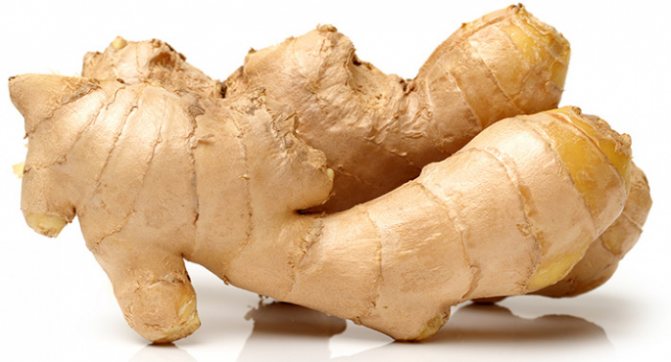

Root
The root has a spicy taste and sounds like ginger in English. The word has a different meaning - piquancy, which fully reflects the quality of the plant.
The composition of ginger and its calorie content
Ginger is a unique combination of trace elements and vitamins. It includes:
- Gingerol (promotes weight loss)
- Essential oils
- Terpenes (widely used in the cosmetic and perfumery industry; in medicine - as part of anthelmintic drugs, expectorants, antiseptics)
- B vitamins (B1-B6, B9)
- Vitamin C (ascorbic acid)
- Vitamin E
- Vitamin K
- Macronutrients: sodium, calcium, magnesium, phosphorus, manganese, copper, iron, selenium, zinc
- Citral (starting compound for vitamin A production)
Caloric content - 80kcal / 100gram. Carbohydrate content 15%.
Ginger for nausea
Of course, not for everyone, but still for many, fresh ginger helps to cope with nausea and in cases where you are seasick in the car and with one of the first symptoms of pregnancy it will make it easier to endure not strong nausea. There are several ways to use ginger for nausea - you can drink cooled or even cold ginger tea, or chew on a small piece of fresh, peeled ginger root. Do not expect that ginger will stop nausea or vomiting in case of poisoning - this problem needs to be addressed separately.
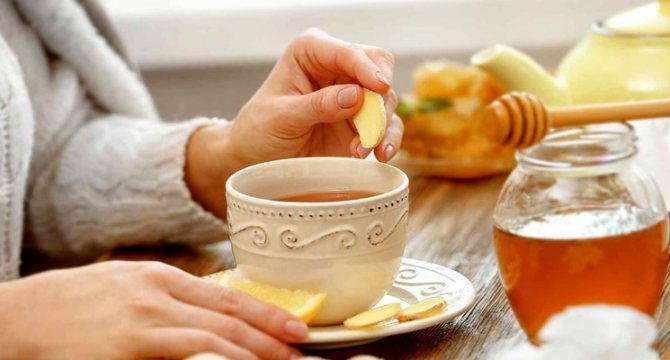

Other anti-inflammatory and antioxidant properties of ginger are due to the fact that it contains beta-carotenoids, capsaicin, caffeine, curcumin and salicylate. Ginger root helps relieve muscle tension and spasms; in oriental medicine, it has been used for many centuries as a fairly strong anti-inflammatory agent. But do not forget that almost every product of plant or animal origin can cause allergies, and have their own contraindications, so caution is paramount, especially if you are trying ginger for the first time.
The benefits of ginger
The roots of the plant are of the greatest value to humans. For therapeutic and prophylactic purposes, it is worth using fresh rhizomes, and dried ginger is suitable as a spice in cooking.
Beneficial features:
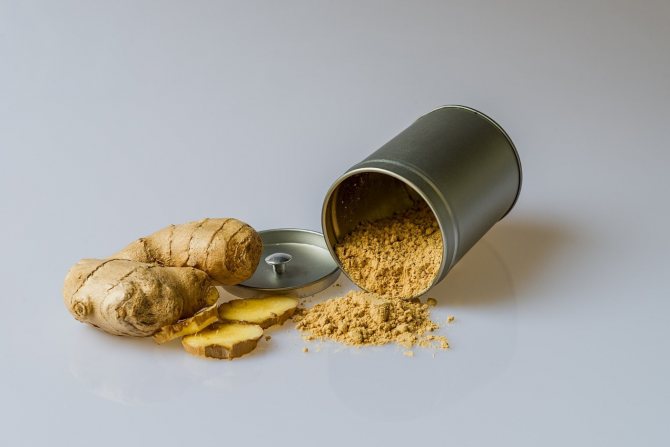

- Helps with seasickness and toxicosis in pregnant women, relieves nausea (fresh (chew a bite) or as a drink)
- Promotes digestion and speeds up metabolism
- Eliminates flatulence, bloating, colic
- Has a mild laxative effect
- Helps to strengthen teeth and gums (rinsing or applying a paste from the grated root)
- Normalizes blood circulation, lowers blood pressure, strengthens the heart muscle
- It is used in the fight against helminths
- Has a tonic and tonic effect on the body
- Has a positive effect on memory
- Improves the quality of the skin
- Reduces acne breakouts.
- Helps with depression and mental disorders (root itself or essential oil).
Benefits for women
It has been documented that ginger has been used as a medicinal plant for over three thousand years. Ancient Chinese healers, as well as Avicenna and Hippocrates, wrote about its amazing beneficial properties.
Almost all of the above positive effects are equally beneficial for the human body, both female and male. But, due to the characteristics of the organism of each of the sexes, additional areas of health can be distinguished, where it invariably has a healing effect.
Especially female problems should not be ignored. The plant is known to reduce pain during menstruation. Since ancient times, it has been used in the treatment of infertility. And, as we already said, this healing root helps relieve nausea during toxicosis in pregnant women. It should be noted that this only applies to the first trimester of pregnancy. At a later date (second or third trimester), it is better to abstain from it, because it reduces blood pressure, and this can harm both the mother and the baby. Eating rhizomes has a beneficial effect on female organs, in particular on the uterus.
The benefits for the body are not limited to this. Ginger is considered an aphrodisiac plant (i.e. it helps to increase libido) due to the fact that it improves blood circulation and promotes blood flow to the pelvic organs.
The dietary properties of the product are also well known. It improves metabolism in the body, removes toxins and toxins, the body begins to burn fat reserves. Due to its properties, the plant is present in many diets.
Benefits for men
What can be especially distinguished from this amazing plant that is beneficial for men's health? In Chinese, the name "ginger" sounds like "masculinity", and it fully corresponds to its name, having a positive effect on the entire male immunity in a complex, in a wide range.
The root is considered a male spice and has been used by the Chinese as an aphrodisiac since ancient times. Essential oils, vitamin C and lysine, in its composition, increase potency, improve the tone of the muscles of the genitals. All due to the fact that it increases blood circulation and blood flow to the organs of the genitourinary system.
Also possessing anti-inflammatory properties, it prevents or reduces the development of prostatitis, and is even used in the treatment of male infertility. The immunological properties of the root should not be underestimated either. Its use helps to increase vitality and improve memory.
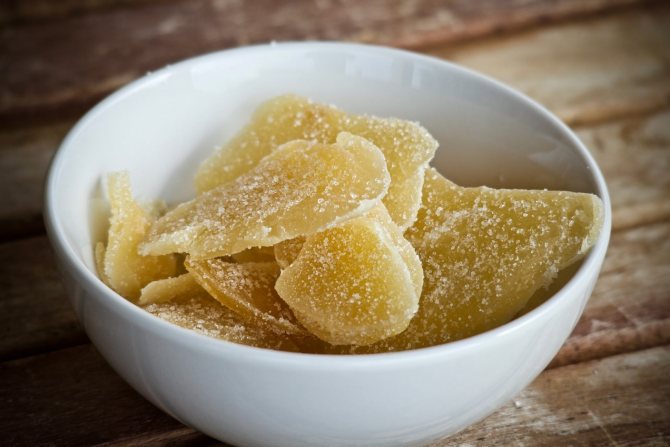

In cosmetology
All people tend to pay attention to external beauty. The condition of our hair and skin is important to us. For centuries, ginger has been used as a base or additive in cosmetics. It can be added to shampoo or hair masks. You can also rub the plant sap into the scalp separately. Thanks to its properties, the hair will acquire a healthier look, become stronger, and dandruff will go away.
Also, it is a very powerful antioxidant, so its regular use frees the body from toxins, removes the released radicals. The skin is cleansed, rejuvenated, looks more well-groomed, acquires a healthy color. For those whose skin is prone to breakouts (for example, teenage acne), it will be useful to know that the derived plants act as an antiseptic and have bactericidal properties. In pharmacies, you can find skin care products with its extract.
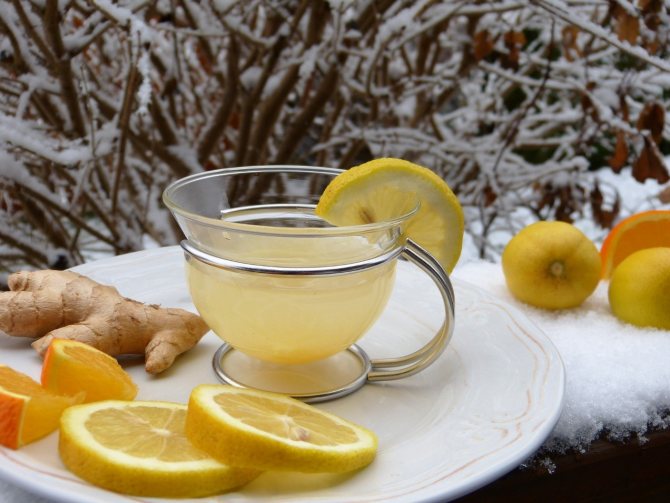

Briefly about the benefits and dangers of ginger for the body
In Indian Vedic medicine, ginger is classified as a versatile medicinal plant that is beneficial to health. It helps to speed up the digestion processes, warms, excites.
In ancient times, the spice was used to treat poisoning, the effects of overeating, colds. The ginger slice was recommended to chew in case of motion sickness, was used to treat toothaches, and in Southeast Asia it was considered a means of prolonging youth and improving memory.
Modern medicine recognizes the vasodilating effect of the spice. Because of its pungent properties, even a small piece of root or ginger tea can cause a diaphoretic effect. The juice of the spicy root promotes the secretion of gastric secretions, irritating the mucous membrane. Essential oils have anti-inflammatory and antiseptic effects, prevent blood clotting.
The harm to a plant is associated with its properties. To avoid heartburn or irritation of the larynx, do not overuse the spicy root or consume large portions of dishes with ginger (the daily intake of the root fresh is 4 g).
The spice also has direct contraindications:
- hyperacid gastritis, stomach ulcer (leads to pain in the stomach, causes bleeding);
- gallstone disease (provokes colic);
- cardiovascular disease (increases heart rate);
- pregnancy (causes uterine bleeding, increases the tone of the uterus);
- it is not recommended to add spice to food for children (under 5 years old).
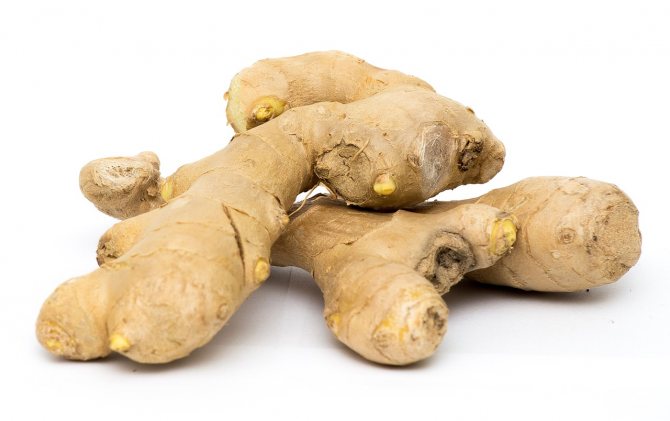

Ginger root has many health benefits.
Harm and medical contraindications
Despite all the listed beneficial properties of the plant, this is not a panacea. Even the best medicine has contraindications. Healing ginger is no exception. Let's talk in more detail about contraindications, and about what harm to health can be in different situations.
First of all, about people with serious disorders of the cardiovascular system. If you have hypertension of the second or third stage, then doctors do not recommend using the root. Why? As already mentioned, it tends to thin the blood. Therefore, in combination with antihypertensive drugs, blood pressure can sharply decrease, and this is life-threatening. In stage 1 hypertension, the plant will help relieve pressure. But you still need to use it carefully.
Also, do not use the root and its derivatives for people with coronary heart disease, stroke or pre-stroke condition, heart attack or pre-infarction condition.
Now about the diseases of the gastrointestinal tract. Gingerol and other substances that make up ginger give it a pungent taste. And this means that it is better for people with stomach diseases to refuse it, tk. it can be irritating to the mucous membrane. Such diseases include: colitis, enterocolitis, ulcer, gastritis, diverticulitis, diverticulosis.
For the same reason, use is contraindicated if there is damage to the mucous membrane in the oral cavity. Liver diseases such as hepatitis, cirrhosis, cholelithiasis are also contraindications for use. Not recommended for children under two years of age. Older children can be given with caution to avoid an allergic reaction.
We repeat once again that pregnant women can use the plant and its derivatives only in the first trimester to relieve symptoms of toxicosis. In the second and third trimester, it is life-threatening for the fetus and the mother, as it can severely lower blood pressure.
Most use the root for colds. But you shouldn't use it if you have a fever, because it makes you feel hot by itself. Bleeding with hemorrhoids, uterine bleeding, frequent nosebleeds are also contraindications.
Although it is recommended for people with diabetes mellitus, it is forbidden to combine it with antidiabetic drugs. You can not combine the drug with antiarrhythmic drugs and hypotonic drugs. In case of an overdose, the following are possible: nausea, vomiting, diarrhea. In this case, you need to urgently stop using.
Where is ginger grown and grown?
It is a perennial herb with erect stems that is very fond of warm and sunny color, high levels of humidity in the air and soil.
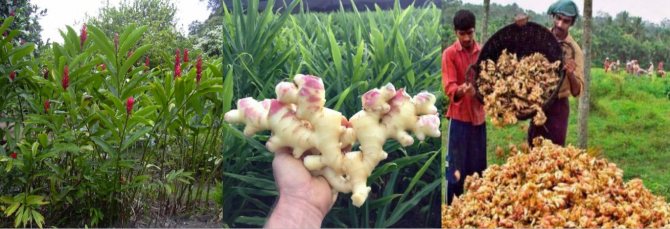

That is why the ginger root grows only in the countries corresponding to these climatic features:
- Japan;
- Vietnam;
- Africa;
- Australia;
- South America (Argentina, Brazil);
- Jamaica island.
The mass spread of the culture began in the eighteenth century, although the first active use was recorded in India as early as the ninth century. The homeland was kept secret - thus the merchants increased the value and shrouded properties in riddles and secrets.
The true medicinal variety of the white root is found only in the rainforests of southern Asia and is nowhere else to be found.
Let's figure out where the ginger root grows in nature? A wild plant has not existed for a long time, although the most suitable climate can be found in southern Africa and eastern Asia. The culture grows in industrial areas under the strict control of people:
- On farms;
- On plantations;
- On the fields.


An important requirement - compliance with weather conditions and careful maintenance. There are small farms and huge plantations, some of which have been functioning for more than two hundred years. Almost all of the harvest received is exported and distributed around the world, and delivered to our country.
Below we will discuss in detail the growth of culture in the Russian Federation. Unfortunately, it is not possible on a large scale - but here are some regions that theoretically would be suitable for growing the spice:
- Krasnodar;
- Crimea;
- Caucasus;
- Moscow region;
- Rostov region.
In any case, the region should be humid and warm.
Selection rules
The root can be found on sale in several forms: fresh, dried and pickled - a different way of storage for different purposes. Dried root works well as a spice. When choosing a dried product, it is necessary to inspect its surface for fogging and mold - of course, they should not be. There should be no lumps in the ground product.
For medicinal purposes, it is best to choose fresh roots. Products often linger on supermarket shelves. If the storage conditions have been violated, the root becomes dryish, shriveled or begins to rot. Choose heavier roots, firm and dense, they have more juice. The benefits of fresh products are always undoubtedly higher than those of dried or pickled ones.
Marinade is equally suitable for cooking and for the prevention of diseases. It is slightly worse than a fresh root, and still retains many active trace elements and nutrients. The marinade is easier to store than the dry product and has a much longer shelf life. If ginger is imported from distant hot countries, then the pickled version will be of higher quality than the dried one.
Cold Treatment and Immunity Support
As a medicine, ginger is extremely useful in the treatment and prevention of colds, especially in winter. Since the plant has good anti-inflammatory properties, you can make ginger tea.
You need to brew in a thermos, you can take both regular black and green tea, leave for 15 minutes. Add fresh ginger, peeled and cut into thin slices, to the finished drink. It is important not to overdo it, since the taste of such an infusion will be too hot. It is good to add a few thin slices of lemon or lime. When the drink is poured into a cup, you need to add 1 tsp to it. honey. You cannot add honey to a thermos, because under the influence of high temperature all useful properties are destroyed. It is better to drink ginger tea in moderation hot, 3 times a day 0.5 hours before meals. Such a delicious medicine can be given to children only by reducing the amount of ginger.
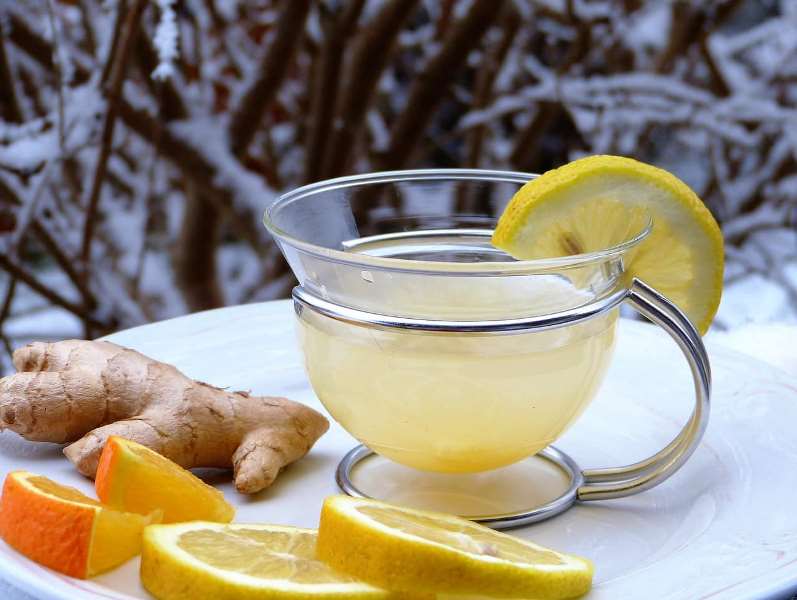

You can use ginger to make non-alcoholic sbitn.It will not only warm you up in the cold season, but also enhance immunity. You will need 1 stalk of lemongrass (available from the spice department), which must be chopped in a blender. Peel a small piece of ginger root, roll with lemongrass. Add 2 tbsp. l. favorite sweet syrup and beat. Strain the resulting mixture into an enamel saucepan, add a glass of warm water, throw in a pinch of cinnamon, 1 clove bud, squeeze the juice of 1-2 lemon slices. Heat to a boil, not forgetting to stir, remove from heat, cool slightly. Strain again into a beautiful glass, add honey and a pinch of ground nutmeg to taste. Drink no more than 1 serving per day, as the drink has a strong tonic effect.
Storage conditions
There are several options for storing ginger at home. Fresh roots are best stored in the refrigerator, pre-packed in plastic wrap. The film will protect the roots from drying out. So it will last up to two weeks. Can be frozen in the freezer. Then it is better to pre-clean and cut the roots for ease of use.
An alternative way is to dry it a little and wrap the plant in thick paper. You can store it at room temperature in a dry place - shelf life is about a month. The dried product is stored mainly in cloth bags, in a dry place at room temperature - the shelf life is up to half a year.
Another option is to grate or cut into thin slices and dry in the oven at 500. Readiness can be determined by touch (ready-made slices break easily). In this form, it can be stored in a tightly closed jar for up to several years.
Another way is to pour honey over the ginger. This mutually reinforces the properties of ginger and honey. The shelf life of such a product is up to six months.
The shelf life of such a product is up to six months. Candied fruits are made from parts of the plant, as well as a marinade - it must be stored in a tightly closed container.
If you have a lot of fresh produce, you can use an electric juicer to juice it out. It is not recommended to store it, as well as to consume it in its pure form. Usually, from juice, or from a root cut into slices, a tincture is prepared on alcohol - 50 to 50 juice and alcohol. A tightly closed bottle of tincture can retain healing properties for up to 3 years. But, if the bottle has already been opened, then the contents can be consumed within 21 days, on day 22 everything that remains should be thrown away.
A tincture of several camellas is used in tea, warm milk or fruit drink. Attention! No tincture is added to hot drinks. Tincture is used to treat colds and infectious diseases.
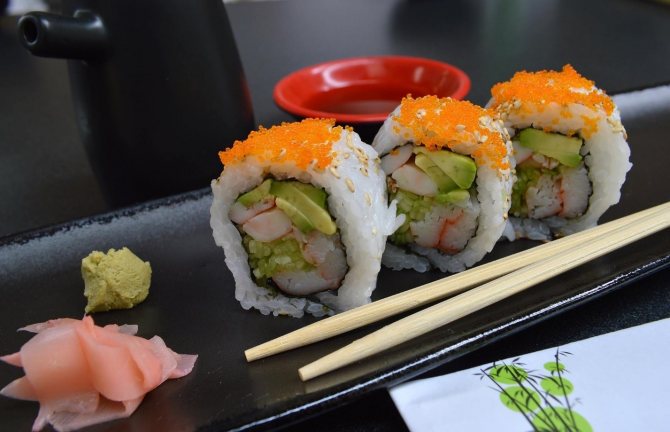

How is ginger grown in his homeland?
Ginger that grows in nature does not occur in the wild. The needs of industry and the population are met by farmers. In specially cultivated fields, the root is cultivated. There are known plantations where ginger grows, with a 200-year history.
Some researchers consider the countries of the East Asian and Pacific region to be the homeland of ginger. The root is supplied to the world market by India, China, Vietnam. Traditionally, the spice is grown in West African countries.
Farmers in East Asia are developing ecotourism on plantations. They invite visitors to spend the day in their fields. People get acquainted with where and how ginger grows, study the peculiarities of cultivation. The opportunity is given to purchase a root grown in an ecologically clean place, products based on it.
Farm shops sell:
- seasonings;
- cream;
- lotions;
- beverages.
Some visitors buy raw ginger. Souvenir products are popular.
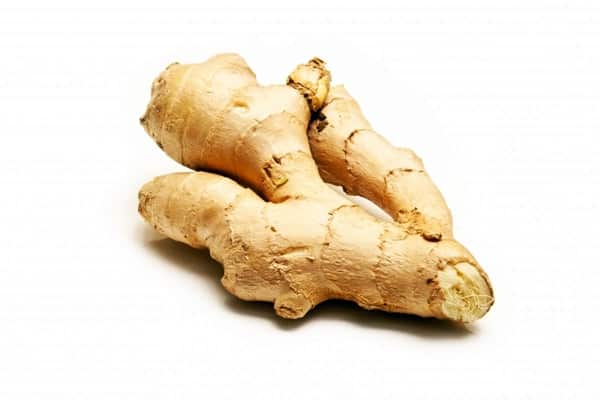

How to eat
Ginger has a spicy aroma and a pungent taste, and is also refreshing.
Before using the rhizomes, it is imperative to wash well under running water, peel them, and you can even place them in cold water for an hour.This is done so that particles of fertilizers and other chemicals that may have been used during cultivation do not enter the body.
On the Internet, you can find dozens of cooking recipes. Here are the most basic ones:
- 1 tbsp grated root is approximately equal to 1 tsp. dry ground. The proportions for cooking - 1 gram of spice per 1 kg of dish.
- Ginger tea. Grate or finely chop a piece of root the size of a phalanx of a little finger, pour a glass of boiling water. Add 2-3 lemon wedges. Cover, let it brew. Then add a spoonful of honey or sugar. If desired, you can add grated or chopped root to any tea.
- Another drink recipe. A piece (2-3 cm) is cut thinly. Thinly chopped quince, a sprig of mint, a few sticks of cloves, cinnamon and 2-3 tsp are added to it. green tea. Pour 500 ml of boiling water. Let it brew for 10 minutes. Then you can add a tablespoon of honey. The drink is ready to drink.
Ginger drinks have anti-inflammatory, soothing, tonic properties. They can be used both hot and cold.
- Pickled ginger. Marinating it is not easy, you have to spend a lot of time. Apple cider vinegar is a good ingredient. The roots must first be washed and peeled. Then they need to be rubbed with salt and sent to the refrigerator for 4 hours. After that, they are washed and poured over with boiling water. When the roots have cooled, they are rubbed in a small vegetable cutter, poured with a marinade of vinegar, salt and sugar. For the traditional pink shade, add grated beets. Now the marinade needs to be infused. This process will take 3 days. After that, the product is ready for use. It is often served with rolls and sushi, as a seasoning that emphasizes the taste of the dish.
- Candied ginger fruits will become an alternative to sweets, and also useful. But be careful - they are high in sugar, which means carbohydrates. You should not get carried away with them.
- Many people add the plant to baked goods (think of the famous gingerbread).
Dried powder is used as a spice for meat and fish dishes (20 minutes before cooking), added to compotes and jam (3 minutes before cooking), in sauces (after removing from heat).


Varieties and types for cultivation
Amaranth plant
The ginger plant has about 140 species. Despite this variety, not all species are suitable for culinary and medical applications. Many wild varieties do not have a distinct taste. Before you start growing a plant at home, you need to find out from which variety you can get spices.
Among the varieties that are suitable for home growing are the following:
- ginger Chrysostom;
- ginger Krasnaya Polyana;
- White ginger;
- ginger Gold;
- ginger Medicinal.
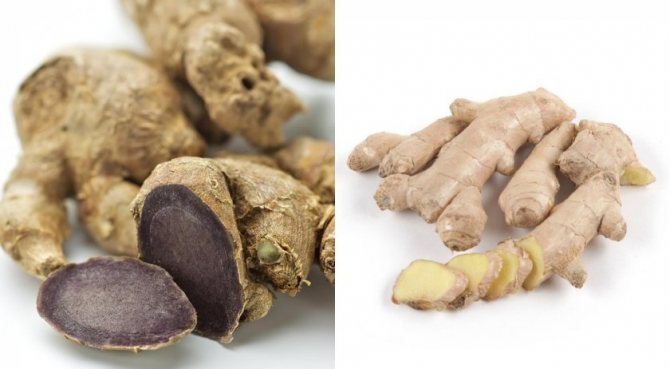

Black and white ginger
All varieties have a characteristic aroma and taste. The aroma may be different, some species smell like grass, others like citrus, and some just like kerosene.
Some species are grown for trade:
- Purple. The second name is Pai. It differs from other varieties in that it has a cooling effect. Used in medicine as a pain reliever. The color of ginger is yellow or green. Inflorescences are white or yellow. The flowers give off a spicy aroma with a camphor note.
- Myoma. This is the only variety that can survive frost. Found wild in Japan. The Japanese use not only rhizomes in cooking, but also flowers.
- White (Bengali). The rhizome is for trade. The fruit is dug up, cleaned and placed in a weak solution of sulfuric acid. This action removes the pungency of the root and gives it softness and a pleasant aroma.
- Black (Barbados). After being removed from the ground, the root crop is poured with boiling water. This activity makes the fruit burning and sharp.
- Pink (Gary). The root has a reddish tint; it becomes yellow-gray when cut.Thanks to vinegar and sugar, it turns red. Gary's root vegetable is often purchased by restaurants and pizzerias. Most delivery services use the plant in their name, for example, "Ginger Zlatoust", "Krasnaya Polyana", Ginger Gold ".
Medicinal ginger is used for medical purposes. The pharmacy plant resembles a pine cone. Inflorescences are purple or yellow.
Interesting! For the preparation of medicines, the roots of the plant are used, they are dug out immediately after flowering. The rhizome is cleaned and dried.
What heals
The root vegetable contains more than 400 useful components: vitamins, micro- and macroelements, organic compounds, acids and essential oils. Due to this, it has a tonic, anti-inflammatory, analgesic, disinfectant effect on the body. What Does Ginger Treat? The root vegetable is effective in the treatment of acute viral diseases, diseases of blood vessels and joints, respiratory tract, gastrointestinal tract, diabetes mellitus.
They use the horned root fresh, in the form of tinctures, juice, powder. Root teas help you lose weight and also remove cholesterol. In order to preserve more nutrients, it is not recommended to boil the fruit or give it a long heat treatment. Not so long ago, this wonderful spice began to be used in the treatment of kidneys and to strengthen blood vessels. Ginger inhalation relieves a runny nose and cough.
Additional Information! White root is classified as a low-calorie food, there are only 80 calories per 100 grams.
What is ginger for in cooking?
When buying a root vegetable, the question often arises: what is ginger for? And which variety is suitable for cooking? The rhizome is used in cooking fresh, dried and pickled. When added to food, it not only adds flavor to dishes, but also benefits the body.
The use of a root vegetable in cooking:
- Beverages. The root is added to kvass, tea is especially good when combined with lemon and honey. It is part of ginger ale and beer, English liqueur.
- Bakery products. The spice is added to the dough, from which gingerbread cookies, gingerbread cookies, biscuits are baked.
- Spice. Used for marinating meat and fish.
- Eastern cuisine. Gary ginger is pickled and served as an appetizer and salads for rolls and sushi.
The root vegetable goes well with other seasonings: star anise, cloves, cinnamon, black pepper, dill and fennel.
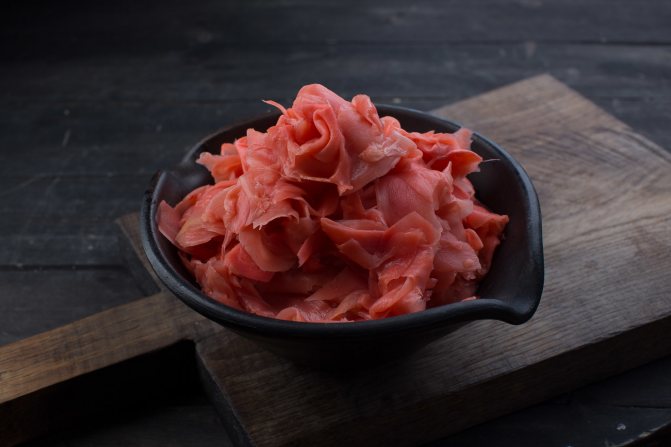

Pickled root vegetable - as an element of Asian cuisine
Turmeric and ginger are the same
When dealing with a southern root vegetable for the first time, many are wondering: are turmeric and ginger the same thing? Although these two spices are related, the answer is no. Outwardly, both cultures are similar. Turmeric is also a root, bright orange or golden in color. The aroma is spicy with hints of citrus.
The seasoning is obtained as follows: the root is boiled or steamed, dried and crushed.
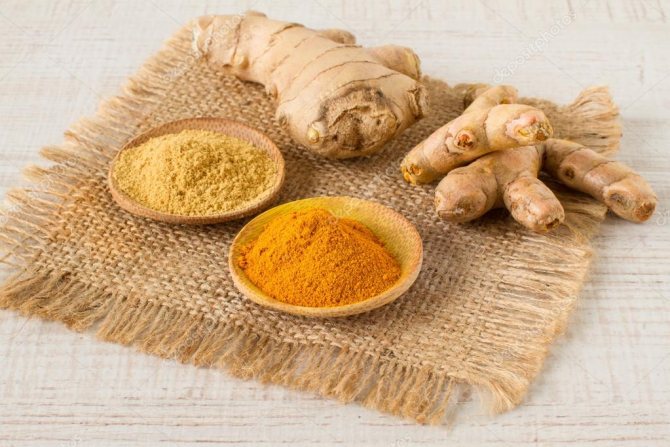

Ginger (left) and turmeric (right)
Additional Information! The main difference between turmeric and ginger as spices is their taste. In the first it is sharp and burning, in the second it is more tender and light.
Both plants belong to the genus Zingiberacea and belong to the same Ginger family. Jerusalem artichoke also belongs to this family. In nutrition, it is used as a rhizome. Like its relatives, it contains a large amount of vitamins, marco and macronutrients. It tastes sweet and smells like potatoes. Unlike ginger, Jerusalem artichoke is fried, boiled, stewed. Horned root is mainly used in cooking for flavoring.
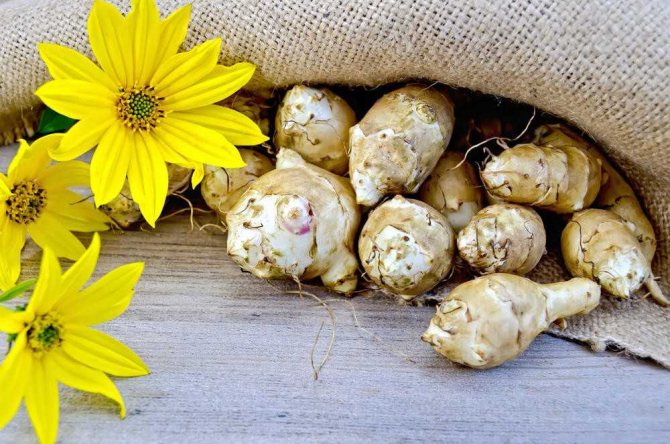

The protein content in Jerusalem artichoke is higher (2 grams)
Ginger in cosmetology
On store shelves and pharmacies, you can see product lines that include ginger root. These can be shampoos, hair masks, caring oils. They are mainly intended for oily and normal hair.The healing components of the plant help to eliminate dandruff, improve blood circulation in the hair follicles and strengthen the hair.
Often this plant is included in the composition of anti-cellulite creams and gels, because it helps to improve metabolism in tissues and organs, improves blood circulation, and eliminates the "orange peel".
The plant extract is included in facial skin care products. Due to its anti-inflammatory and antiseptic effects, it promotes wound healing and acne elimination. Products with it are ideal for oily and combination skin. Skin prone to breakouts and acne. The substances included in its composition whiten, remove freckles and age spots.
The extract tones, improves blood circulation, giving the skin a healthier, radiant, toned look. Due to its antifungal properties, the extract is used in antifungal agents and foot creams.
In this article, we have learned a lot of useful and interesting things about ginger. The next time you see these unusual roots in the store, do not pass by, be sure to stock up on this usefulness. Treatment with ginger, the benefits it brings, will help maintain health and give vitality to all family members.
Ginger for Men's Health
According to scientists, ginger is one of the five best medicinal plants for men's health. It can be considered a sex stimulant. Regular intake of ginger and preparations with it improves the functioning of the vascular system, blood circulation, and removes bad cholesterol from the body. A man will always be in good shape, an erection is in a normal state. Ginger is a wonderful aphrodisiac.
You may be interested in: Barberry tea and its healing properties
There are a lot of vitamins in the root of ginger, they are able to stimulate the work of the pelvic organs. Zinc increases testosterone production. The plant helps fight germs and bacteria, it helps in the treatment of sexual diseases, inflammatory processes.
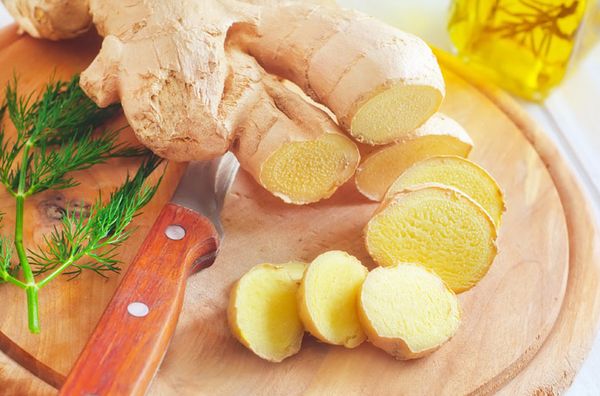

The benefits of spices for women
The medicinal properties of ginger are largely due to the nutrient composition of the root vegetable. The calorie content of the root per 100 grams is only 80 Kcal. The plant contains:
- sugar;
- calcium compounds;
- vitamin C, B6;
- manganese;
- iron.
And also: choline, threonine, chromium, leucine, phosphorus, oleic, nicotinic, caprylic, linolenic acids. Despite such a rich variety of vitamins, micro- and macroelements, it also contains rare compounds, namely:
- bisabolic;
- cineole;
- citral;
- borneol;
- pellandrene;
- tsingiberen.
There is no cholesterol in the rhizome, which makes it especially useful for those who suffer from atherosclerosis and obesity.
Why is ginger useful for women:
- tones up;
- eliminates edema;
- has a tonic and antiviral effect;
- promotes the acceleration of metabolic processes;
- increases sweating, helping to eliminate toxic compounds;
- saturates the blood with oxygen;
- reduces the risk of blood clots by strengthening blood vessels;
- saturates the body with phytonutrients.
It is applied when:
- toxicosis and dysbiosis;
- decreased immunity;
- infections of various origins;
- thrombophlebitis;
- swelling and inflammation of the musculoskeletal system;
- spastic pain and to relieve migraine.
But the benefits are possible only if there are no contraindications to its use.


In the conditions of modern realities, the use of natural healthy products is a guarantee of health and a preventive measure.
Why pickled ginger is useful and harmful
Ah, that magical scent of pickled ginger! In this form, the beneficial properties of the spice are activated, essential oils act especially strongly, strengthening resolve, relieving fear and bestowing vitality, and there are very few contraindications. This is how the Japanese say about the product, and as for their attitude to medicine, they are worthy of faith.
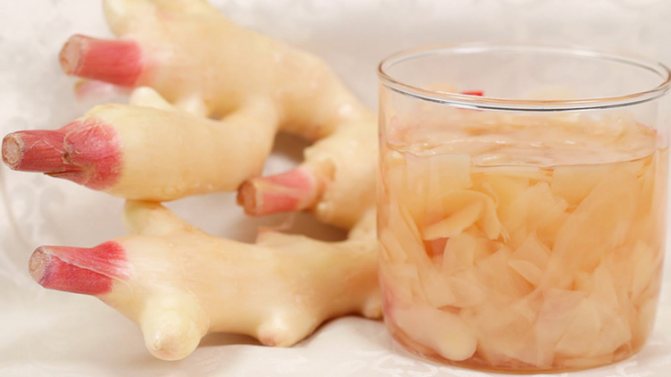

Pickled spice can replace some antidepressants due to its composition
The benefits of pickled ginger for colds are invaluable. The harm from a viral attack is easily removed with a drink from the miraculous root. Digestion problems recede, aging processes slow down, "seasickness" is muffled. Let's add a few words about the benefits of pink pickled ginger: its reception helps to activate potency in men and starts the process of losing weight in women. The harm is due to the presence of contraindications: you should not be zealous with the intake of a ginger product for people with ulcers and gastritis, as well as during breastfeeding. The spice in this form is recommended for people with problems in the supply of oxygen to the brain.
The healing properties of ginger
Treatment of colds
The beneficial properties of ginger are successfully used in the treatment of many diseases. For example, it is good to apply ginger for colds... Its antibacterial, antiseptic, expectorant properties are well-proven in the treatment of seasonal viral and colds.
It perfectly relieves symptoms such as runny nose, cough, sore throat. The simplest treatment is to take a ginger drink, most often tea. This tea should be taken 3-4 times in one cup during the day. Ginger for cough tea should be drunk in small sips. You can use ginger juice, infusion, broth, ginger essential oil.
Prevention and treatment of cardiovascular diseases
Ginger is used in the treatment of cardiovascular diseases. For example, it is believed to be useful for both high and low blood pressure. This raises the question - Does ginger raise or lower blood pressure?
It turns out that this amazing root normalizes blood pressure in both cases. Its use has a beneficial effect on the condition of hypertensive patients. In hypotonic patients, when taking ginger root, the muscle tone of the vessels increases, and the pressure rises from a low value to normal.
Ginger is also recommended for those whose blood pressure "jumps", then increasing, then sharply decreasing. Ginger, heats the blood, makes it less thick, saturates with oxygen. The peripheral vessels relax, their spasms are relieved and the patient's condition improves.
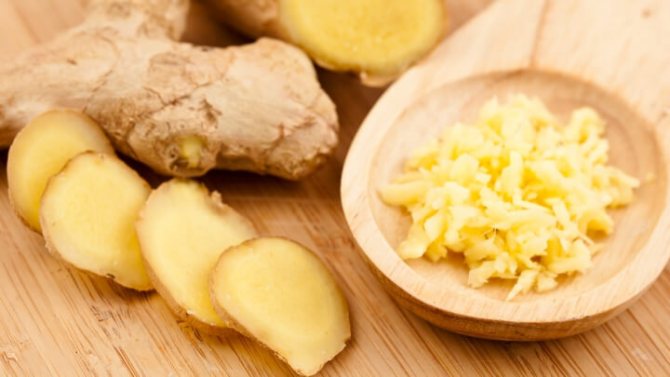

Use of ginger for diabetes
Ginger for type 2 diabetes is recommended for use because:
- Reduces blood sugar levels.
- It has anti-inflammatory and wound healing properties.
- Burns excess fat and reduces weight.
- Improves the digestion process.
- Eliminates cholesterol deposits in blood vessels.
The main advantage of ginger in diabetes mellitus is the normalization of carbohydrate and fat metabolism, which is very important in this disease. Therefore, in type 2 diabetes mellitus, ginger is very useful and is recommended by endocrinologists.
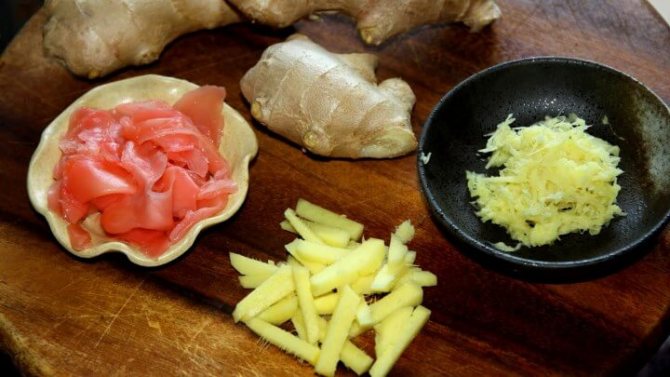

Strengthening the body's defenses
Due to its unique composition, it makes sense to use ginger for immunity. To increase the body's defenses after viral and colds, there is a wonderful recipe that includes ginger. it ginger with lemon and honey, recipe for health. Each of the three components of the recipe has its own special properties. Combined with each other, they provide an excellent immune recovery effect.
The health recipe has the following composition: ginger root - 400 g, lemon - 4 pcs., liquid honey - 200 g.
Rinse the lemons and cut into wedges. Peel the ginger and cut into small pieces. Pass the cooked lemons and ginger through a meat grinder, put in a glass jar and pour over with honey. Cover the resulting mixture and let it brew in a cool, dark place for 4–5 days.
You need to take the mixture daily for 1 tbsp. spoon half an hour before breakfast and drink one glass of water. EThis elixir of health cleans blood vessels, reduces weight, strengthens the body's defenses.
The use of ginger for cancer
The developments of American scientists have found that cancer cells can be affected by drugs based on ginger. The substance gingerol contained in ginger root acts on cancer cells and stops their development, and then reduces their growth.
Studies have proven the effectiveness of ginger root in stopping an already begun pathological process, and in some cases, its self-destruction.
Therefore, ginger is recommended by physicians as a prophylaxis for cancer, especially colon and rectal cancer.
Cancer patients undergoing severe chemotherapy may take ginger to relieve symptoms of nausea and vomiting.
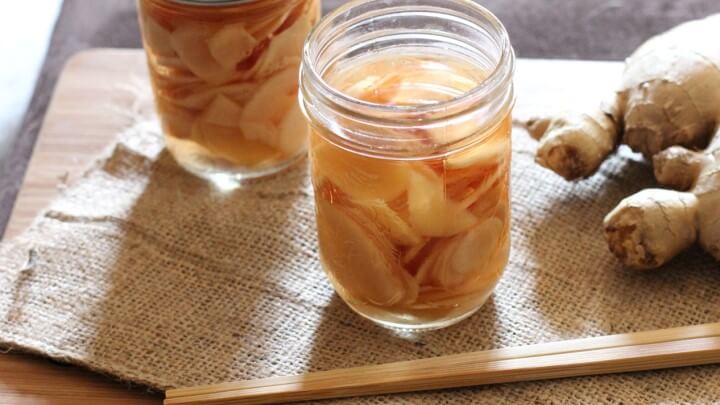

Treating certain eye conditions such as blepharitis
Washing the eyes with eye drops containing ginger juice helps relieve inflammation and allergies.
Studies conducted with ginger have shown that the beneficial properties of ginger have a pronounced medicinal focus:
- Anti-inflammatory and antibacterial;
- Antispasmodic (relieves spasms of blood vessels and improves their patency);
- Anti-sclerotic (cleans the walls of blood vessels, prevents the formation of blood clots);
- Cardiotonic (restores the tone of the heart muscle);
- Diaphoretic;
- Choleretic;
- Stimulates the digestive tract;
- Normalizes blood cholesterol levels, prevents its accumulation;
- General tonic and tonic (increases mental and physical performance, strengthens the body's defenses).
Contraindications for ginger
So, considering the question of whether ginger has beneficial properties and contraindications, it is easy to be convinced of its excellent medicinal qualities. But, Does ginger have contraindications? It turns out that it does.
- Do not take ginger during late pregnancy;
- Do not use ginger if you are breastfeeding a baby.
- Do not use ginger for exacerbation of gastrointestinal diseases (colitis, gastric ulcer and duodenal ulcer);
- It is forbidden to use ginger for cirrhosis of the liver and cholelithiasis;
- It is not recommended to use ginger masks and creams for skin diseases, since ginger has a pronounced local irritant effect, which can aggravate skin problems;
- You can not use ginger root in all forms for bleeding;
- Do not use ginger root at elevated temperatures, as the temperature may rise even higher;
- Ginger should be used with caution for cardiovascular diseases.
When deciding to take ginger as an adjunct treatment, it is worth consulting with your doctor. There are medications that should not be taken with ginger root (eg, antiarrhythmics, blood pressure medications, blood sugar).
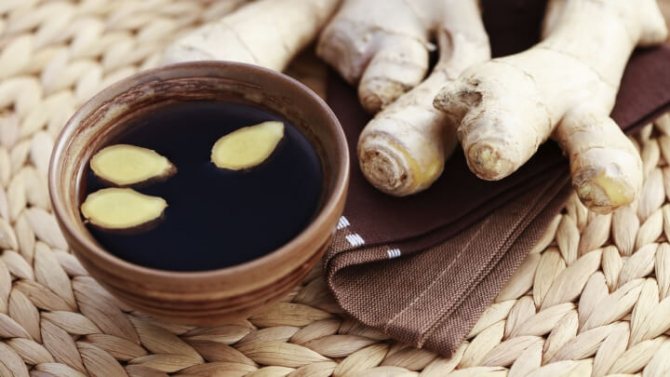

Application options
Scientists note the medicinal effect on the woman's body in menopausal manifestations and infertility, obesity, decreased sexual desire, treatment of diseases of the reproductive system, as well as to improve the condition of hair and skin. Moreover, they use it fresh, dried, pickled, and even as part of drinks.
When losing weight
Ginger is a natural antioxidant and antidepressant, dramatically reducing the production of stress hormone cortisol. What eliminates the craving for "seizing" stressful situations, while contributing to the reduction of excess calories.
The plant owes its sharpness to a substance called "gingerol", which promotes the secretion of saliva, gastric juice, bile, and the breakdown of complex fats. As a result, the digestion process improves, as well as metabolic processes. This means that weight loss is faster.
For gynecological diseases
The medicinal properties of the root crop are also noted in pathologies of the woman's reproductive system. The main thing for women's health is prevention. The use of a spicy root can not only serve as a treatment, but also prevent a number of ailments.
So, herbal infusions with the addition of ginger help to cope with cramps and malaise during menstruation and restore the menstrual cycle. Contributes to the normalization of hormonal levels, kidney and liver function.
The use of spices helps to improve the blood flow of the uterus, prevents the development of tumors and benign neoplasms (namely, fibroids, fibroids, cystic and other germ cell formations).
Japanese scientists have created a preparation containing ginger root extract (in a predominant ratio) and about 12 plant components. His research was conducted on more than 100 women with gynecological pathologies.
The results of a clinical experiment confirmed that the agent helps to restore a woman's reproductive health, stops adhesions and prevents the development of oncology.


The spicy root helps to restore reproductive health, significantly increasing the chances of conceiving a child.
With infertility
As early as the 19th century, women believed that ginger root aided in conception planning. And for good reason, the whole point is that the plant regulates the production of hormones, normalizes the maturation of eggs and the female cycle. That provides favorable conditions for the successful conception and bearing of the child.
It is recommended to drink ginger tea, adding the spice in powder form or fresh in small pieces.
With menopause
In the period from 45 to 55 years in women, a period of physiological restructuring of the body begins with involution and extinction of reproductive functions (menopause).
Depending on the individual characteristics, the manifestations of the climacteric period may be subtle or cause serious discomfort:
- headaches;
- increased sweating;
- hot flashes (a sharp increase in body temperature, the appearance of red spots on the body);
- weakness;
- fragility of bones;
- irritability;
- sleep disturbance;
- problems in intimate life (dry mucous membranes, painful intercourse, decreased libido).
Tea and decoctions with the addition of a spicy plant will help alleviate the condition. They help to relax muscles, relieve irritability and discomfort in general.
During pregnancy
Ginger for women during pregnancy has:
- calming effect;
- relieves muscle spasms;
- eases the condition with toxicosis.
In addition, it helps to cope with emotional changes. Normalizes the work of the digestive tract, relieves constipation and increased gas formation, characteristic of this period.
However, it should be borne in mind that ginger root helps to increase the tone of the uterus, so you should not use the spice in the late gestation period.


The use of spices helps to alleviate the manifestations of climacteric disorders.
During lactation
Often during breastfeeding, milk production is not sufficient for the baby. Ginger helps to increase lactation.
For this purpose, nursing mothers can use a spicy root no earlier than in the third month of a baby's life (the daily rate is no more than 3 g). It is also necessary to monitor the child's reaction to this product. When a baby develops increased excitability, sleep disturbances or allergic reactions, you should stop using it.
The root can be eaten in any form, added to 1 and 2 dishes, and made tea with ginger. The infusion is also effective:
- Rinse the ginger root, remove the skin, chop the pulp on a fine grater (3 g is required).
- Pour 350 ml of boiling water over the mass and let it brew for 10-15 minutes.
- Drinking such an infusion should be 1/2 hour before a meal (100 ml each) no more than three times a day.
Consuming the spice to increase breast milk production should be done after consulting your doctor.
As an aphrodisiac
Ginger root improves circulation and is therefore a powerful natural libido enhancing agent.
If you eat a small piece of root vegetable daily or add it to a drink, you can significantly increase libido and sexual activity. In addition, the plant eliminates the inflammatory processes of the genitourinary system.
For the beauty of skin and hair
Even in ancient times, women of the East added ginger extract to cosmetics. If you add it to a rinse, mask or shampoo, you can strengthen the hair roots.
Also, the use of a spicy root and its use in the composition of means for external application can improve the condition of the skin:
- narrow pores;
- to level rashes and redness;
- normalize the work of the sebaceous glands.
Such funds tone and soothe the skin, saturate it with vitamins, and remove toxins. In addition, they are able to influence age-related changes.
Homemade beauty recipes using the herb are easy to prepare. To strengthen hair:
- It is necessary to mix 50 ml of honey, yolk and 1 tbsp. l. spice powder. The mass should be homogeneous.
- It should be spread over its entire length and left for half an hour. Then rinse thoroughly with shampoo and apply a moisturizing mask.


The use of plant-based home hair care products helps to enhance hair growth and restore structure.
An alternative hair care product includes:
- Grate the fresh root on a fine grater, separate the juice from the resulting mass.
- Apply it with light massaging movements on the scalp and distribute over the entire length.
- Cover the head with cellophane wrap and insulate with a towel, stand for an hour.
- Then wash off with shampoo.
The procedures should be repeated 1-2 times a week. Hair will become shiny, thicker and healthier.
To cure acne, get rid of rashes, you can prepare a tonic. For this:
- You will need 10 g of celandine and burdock root, 40 g of birch, elecampane leaves and St. John's wort, 50 g of ground ginger.
- Mix all components, separate 60 grams of the mixture and pour 1 liter of water.
- Boil the solution for 15 minutes over low heat, then cool and strain.
- Wipe your face with the resulting tonic three times a day for 3 weeks, then take a break for 21 days. It should be stored in the refrigerator, but no longer than a week.
Also, ginger works well as part of anti-cellulite products (wraps, scrubs).

